Polymethyl Methacrylate, or PMMA, is a versatile synthetic polymer. Known as acrylic, Plexiglas, or organic glass, it's revolutionizing various industries.
From automotive to construction, PMMA's unique properties make it indispensable. In this post, we'll explore PMMA's characteristics, applications, and why it's crucial in modern manufacturing.
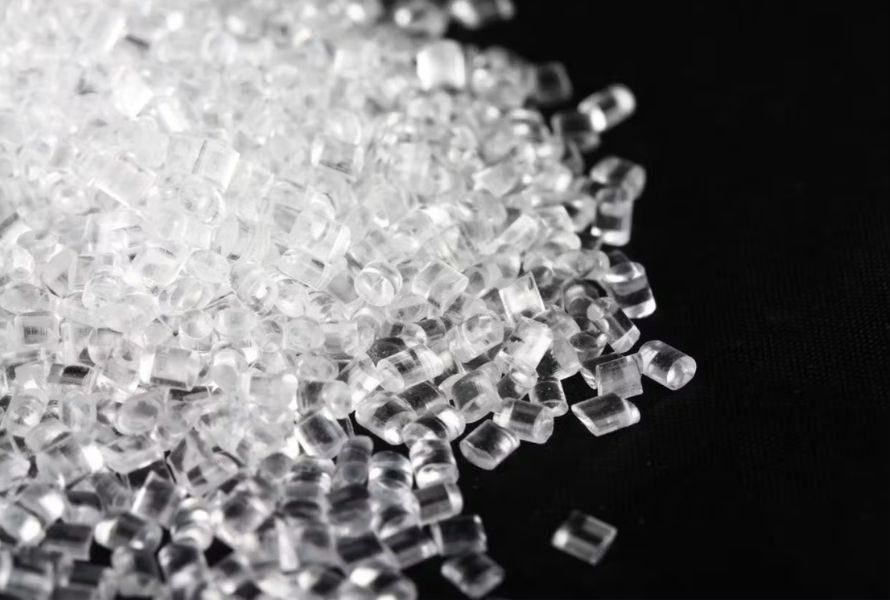
What is PMMA?
PMMA, or Polymethyl Methacrylate, is a versatile synthetic polymer. It's known for its remarkable clarity and durability. This transparent, rigid thermoplastic serves as an excellent alternative to glass and polycarbonate.
Often called acrylic or Plexiglas, PMMA boasts impressive properties:
Lightweight (40% lighter than glass)
Shatter-resistant (10 times stronger than regular glass)
High light transmission (92% light passes through)
UV and weather-resistant
Molecular Structure
At its core, PMMA is formed from Methyl Methacrylate (MMA) monomers. The molecular formula of MMA is C5H8O2 or CH2=CCH3COOCH3.
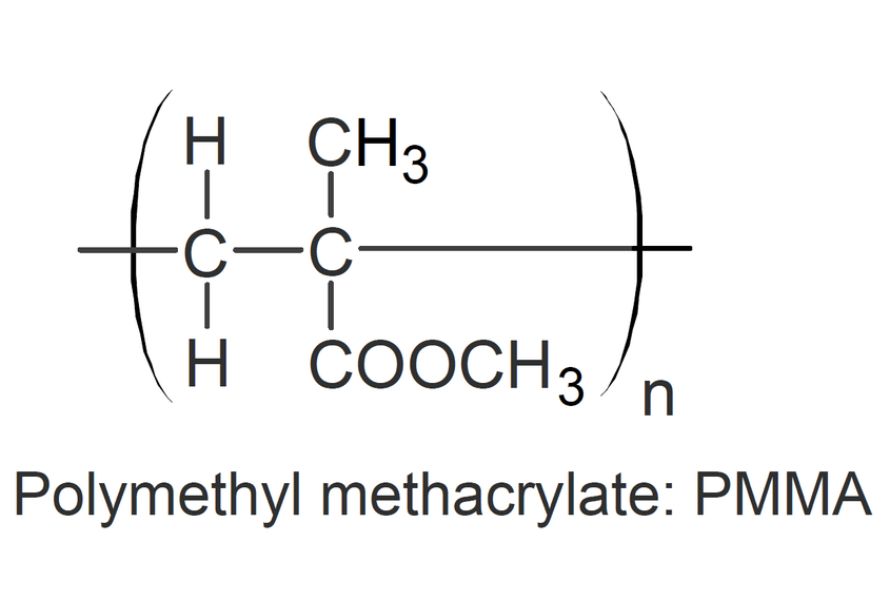
Structure of PMMA plastic
PMMA's structure contributes to its unique characteristics:
Fibrous molecular arrangement
Spatial network configuration
Linear polymer with ester bonds
PMMA shares some similarities with other plastics like PET and PS in terms of transparency and versatility. However, it has its own unique properties that make it suitable for specific applications. For more information on how PMMA can be processed, you might be interested in learning about acrylic injection molding.
Properties of PMMA (Acrylic)
Physical Properties of PMMA
| Property | Value/Description |
| Density | 1.17-1.20 g/cm³ |
| Optical Clarity | 92% light transmittance |
| Surface Hardness | High |
| Scratch Resistance | Good (better than other transparent polymers like Polycarbonate, but less than glass) |
| Weight | 40% lighter than glass |
| UV Resistance | Excellent resistance to UV radiation |
| Weathering Resistance | High resistance to weathering |
| Transparency | Excellent (colorless and clear) |
| Refractive Index | 1.49 |
Mechanical properties of PMMA
| Mechanical Property | Description |
| Tensile Strength | 65 MPa / 9400 psi |
| Flexural Strength | 90 MPa / 13000 psi |
| Tensile Modulus | 2300-3300 MPa |
| Surface Hardness | High |
| Impact Resistance | Lower compared to some plastics, but higher than glass |
| Scratch Resistance | Good (better than other transparent polymers like Polycarbonate, but less than glass) |
| Dimensional Stability | Good (due to low moisture absorption) |
| Toughness | Moderate (homopolymers are brittle, copolymers are tough) |
| Stiffness | High |
| Fatigue Behavior | Can be observed from the Wöhler curve of flexural strength versus number of cycles |
| Brittleness | Remains brittle even at higher temperatures |
Thermal Properties of PMMA
| Thermal Property | Value/Description |
| Glass Transition Temperature | 106°C (up to 115°C for cast blanks) |
| Softening Temperature (Vicat B) | 84-111°C (depending on mean molar mass) |
| Heat Deflection Temperature | 95°C / 203°F (@ 0.46 MPa/66 psi) |
| Maximum Long-term Use Temperature | Up to 70°C |
| Auto-ignition Temperature | 400-465°C |
| Heat Resistance | 60-80°C (general range) |
| Thermal Expansion | Higher than glass or metals |
| Flammability | Easily flammable (UL 94 HB classification) |
| Melting Temperature (for processing) | 200-250°C (injection molding) |
| Extrusion Temperature | 180-250°C |
| Thermoforming Temperature | 150-180°C (up to 200°C for high molar mass types) |
Chemical Resistance of PMMA
| Chemical Resistance | Description |
| Resistant to | Weak acids and alkalis Salt solutions Aliphatic hydrocarbons Non-polar solvents Fats and oils Water Detergents |
| Not resistant to | Strong acids and alkalis Benzene Polar solvents Ketones Esters Ethers Aromatic hydrocarbons Chlorinated hydrocarbons |
| Specific vulnerabilities | Susceptible to stress corrosion cracking Can be damaged by certain solvents like H2O2, Acetone, Alcohol |
| Weather resistance | Excellent resistance to weathering and ultraviolet radiation |
| Water absorption | Low moisture and water absorption |
| Salt water resistance | Unaffected by saltwater |
Electrical Properties of PMMA
| Electrical Property | Description |
| Electrical Insulation | Good electrical insulator, especially at low frequencies |
| High Frequency Performance | Below polyethylene and polystyrene in insulating capabilities |
| Loss Factor | Remains stable during normal use |
| Surface Resistance | Remains stable during normal use |
| Suitability | Advantageous for producing parts in the electrical industry |
| Static Charge | Prone to surface charge creation |
| Antistatic Properties | Often requires antistatic additives |
| Dielectric Strength | High |
| Dissipation Factor | Low |
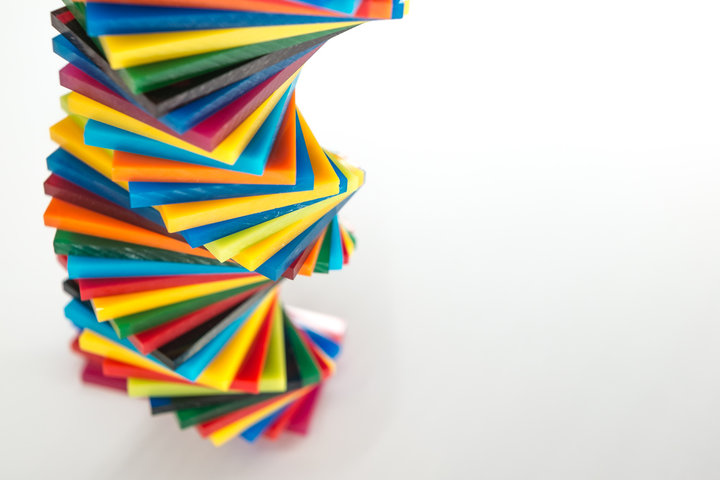
Production of PMMA
PMMA, or acrylic, is produced by polymerizing methyl methacrylate (MMA). MMA is an organic compound with the formula CH2=C(CH3)COOCH3. It's a colorless, odorless liquid.
Polymerization of MMA
The polymerization of MMA can be done using various methods:
Thermal Polymerization
Most common method for PMMA production
MMA is heated to 100-150°C
At this temperature, MMA molecules combine to form polymer chains
Catalytic Polymerization
Radiation Polymerization
The choice of polymerization method depends on the desired properties and end-use applications of the PMMA.
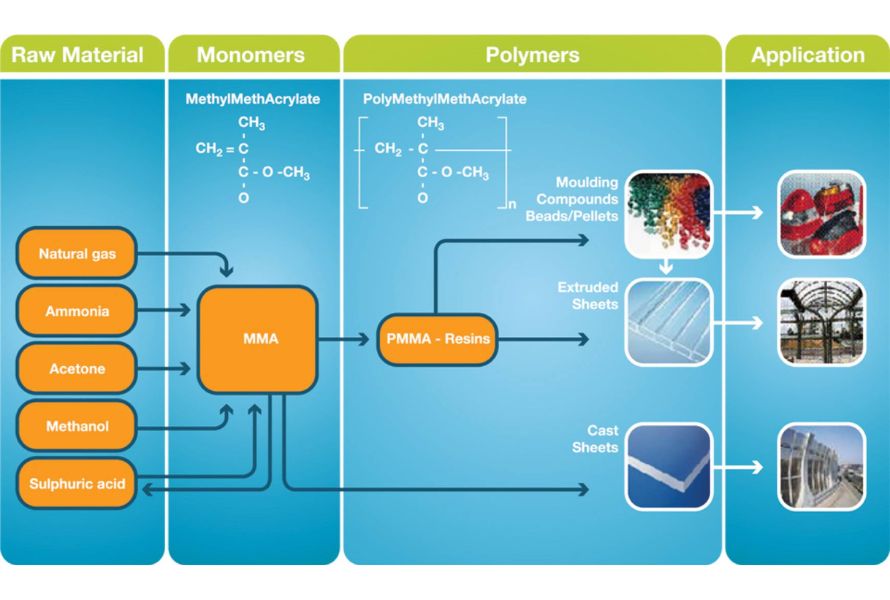
Sourcing from EUROplas
Formation of PMMA Products
After polymerization, PMMA can be formed into various shapes:
Sheets and blocks
Produced by cell casting or extrusion
Used for applications like signs, aquariums, and glazing
Beads
Resins
The formation process influences the final properties of the PMMA product. For example, cell-cast sheets have superior optical clarity compared to extruded ones.
MMA is produced by the copolymerization of acryloyl chloride with methanol. This process ensures a high-purity monomer for PMMA production.
The thermal and catalytic polymerization methods are the most widely used in the industry. They provide a good balance of production efficiency and product quality.
Radiation polymerization, while less common, offers unique advantages. It allows for precise control over the polymerization process and can produce PMMA with specific properties.
Processing Methods for PMMA Plastic
PMMA can be processed using various methods, depending on the desired shape and properties of the final product.
Injection Molding
Melted PMMA is injected into a mold cavity
Allows for complex shapes with high precision
Advantages: fast, efficient, and suitable for mass production
For more detailed information on this process, you can refer to our guide on acrylic injection molding.
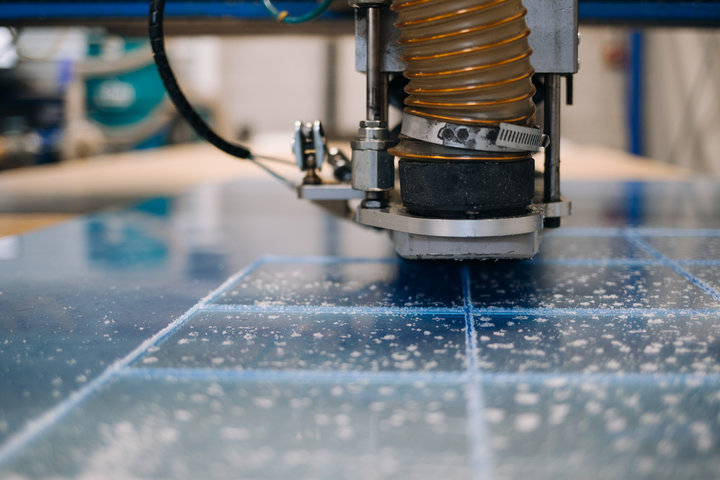
Mold Design Considerations
Draft angles for easy part removal
Uniform wall thickness for even cooling
Proper gating and venting to avoid defects
Troubleshooting Common Defects
Sink marks: caused by thick walls or insufficient cooling
Warping: due to uneven cooling or high molding stresses
Burn marks: result from overheating or trapped air
For a comprehensive list of potential issues, check our guide on injection molding defects.
Key Aspects
Pre-drying PMMA to prevent moisture-related defects
Controlling processing temperatures (200-250°C)
Designing draft angles (1-2°) for easy ejection
Annealing molded parts to relieve internal stresses
To ensure high-quality results, it's crucial to maintain proper injection molding tolerances.
Extrusion
PMMA is melted and forced through a die
Produces continuous profiles or sheets
Advantages: cost-effective for long, consistent shapes
Die Design and Calibration
Downstream Processes
Cutting extruded profiles to desired lengths
Drilling holes or milling features
Secondary operations like bending or forming
Thermoforming
Heating PMMA sheets until pliable
Shaping the sheet over a mold using vacuum or pressure
Advantages: large, thin-walled parts with complex curves
Mold Materials and Heating Methods
Molds can be made from wood, aluminum, or composite materials
Heating methods include infrared, convection, and contact heating
Trimming and Finishing
Machining and Fabrication
PMMA can be machined using conventional tools
Cutting, drilling, and milling are common operations
Advantages: versatile and suitable for small batches or prototypes
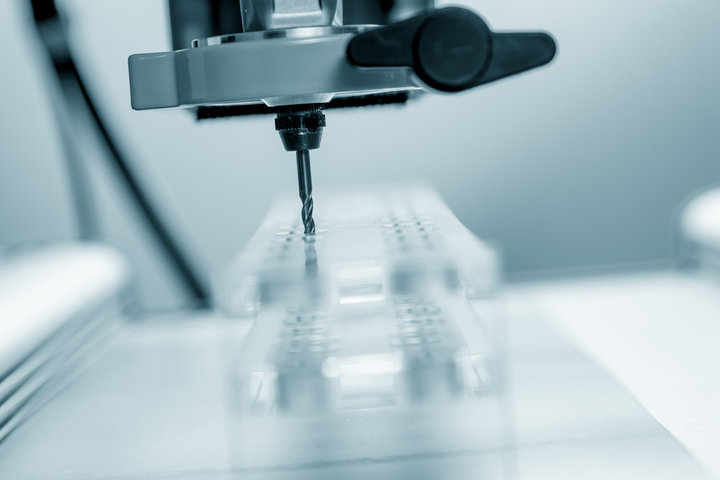
Laser Cutting and Engraving
Polishing and Surface Treatment
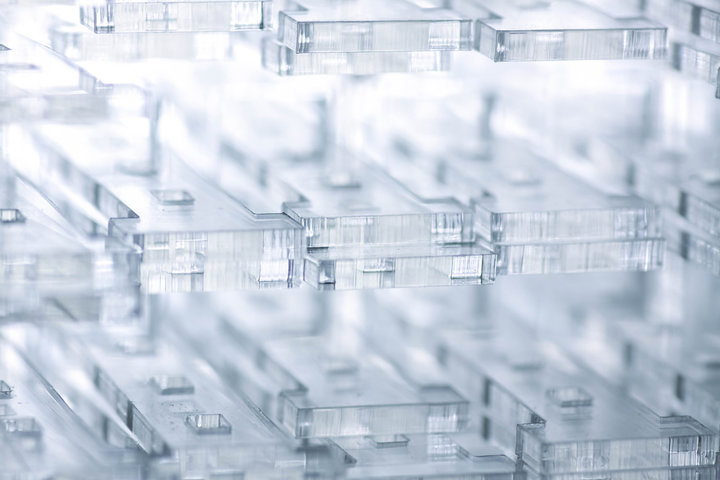
Bonding and Assembly
PMMA parts can be joined using various methods
Solvent welding: using solvents to dissolve and fuse parts together
Cement bonding: using PMMA-compatible adhesives
Mechanical Fastening and Snap-Fits
Using screws, bolts, or snap-fit joints
Allows for disassembly and replacement of parts
Overmolding and Insert Molding
Molding PMMA over another material or component
Creates a strong, integrated bond between the materials
For more information on this technique, see our guide on Insert Molding.
The choice of processing method depends on factors such as:
For precise calculations in the injection molding process, refer to our guide on calculation formulas for injection molding.
Enhancing PMMA Material Properties
PMMA is a versatile plastic, but sometimes it needs a boost to meet specific application requirements. That's where additives come in. They can enhance PMMA's properties, making it even more useful.
Impact Modifiers
Increase PMMA's toughness and impact resistance
Ideal for safety glazing and high-impact applications
Examples: rubber particles, core-shell modifiers
UV Stabilizers
Protect PMMA from yellowing and degradation caused by UV exposure
Essential for outdoor applications and long-term use
Common UV stabilizers: benzotriazoles, benzophenones, HALS
Plasticizers
Enhance PMMA's flexibility and softness
Useful for applications like contact lenses and flexible displays
Examples: dibutyl phthalate, dioctyl phthalate, butyl benzyl phthalate
Colorants and Dyes
Add color to PMMA for decorative and functional purposes
Can create transparent, translucent, or opaque hues
Types: organic dyes, inorganic pigments, special effect pigments
Co-monomers
Modify PMMA's properties by incorporating other monomers
Methyl acrylate improves thermal stability and reduces depolymerization during processing
Other co-monomers: ethyl acrylate, butyl acrylate, styrene
Fillers
Improve PMMA's strength, stiffness, and dimensional stability
Reduce cost by replacing a portion of the polymer
Examples: glass fibers, carbon fibers, mineral fillers
These additives are incorporated during the polymerization process or through compounding. The choice of additive depends on the specific property enhancement required.
| Additive | Function |
| Impact Modifiers | Increase toughness and impact resistance |
| UV Stabilizers | Protect against yellowing and degradation from UV exposure |
| Plasticizers | Enhance flexibility and softness |
| Colorants & Dyes | Add color for decorative and functional purposes |
| Co-monomers | Modify properties like thermal stability |
| Fillers | Improve strength, stiffness, and cost-effectiveness |
By selecting the right additives and optimizing their concentrations, manufacturers can tailor PMMA's properties to suit specific applications. This customization expands PMMA's usefulness across various industries.
It's important to note that while additives can enhance certain properties, they may also have trade-offs. For example, adding impact modifiers may slightly reduce transparency. Careful formulation is necessary to balance the desired properties.
Types of PMMA
PMMA comes in various types, each with unique properties and applications. Let's explore some of the most common varieties.
Standard PMMA
The most widely used type of PMMA
Offers excellent optical clarity and weather resistance
Ideal for general-purpose applications
Display cases
Windows
Lenses
Impact-Modified PMMA
Blended with impact modifiers for increased toughness
Maintains high level of transparency
Suitable for high-impact applications
Safety glazing
Protective barriers
UV-Resistant PMMA
Extruded PMMA
Produced through extrusion processes
Ensures uniform thickness throughout
Commonly used for creating continuous profiles
Cast PMMA
Manufactured by pouring liquid PMMA resin into molds
Results in superior optical clarity
Typically used in applications requiring high-quality surfaces
Medical devices
Optical lenses
Colored PMMA
Heat-Resistant PMMA
Formulated for enhanced heat resistance
Suitable for higher temperature applications
Used where typical PMMA would soften or deform
Here's a quick comparison table:
| Type | Key Properties | Common Applications |
| Standard PMMA | Excellent optical clarity, weather resistance | Display cases, windows, lenses |
| Impact-Modified | Increased toughness, maintains transparency | Safety glazing, protective barriers |
| UV-Resistant | Resists yellowing and degradation from UV exposure | Skylights, signage, automotive parts |
| Extruded | Uniform thickness, continuous profiles | Sheets, rods, tubes |
| Cast | Superior optical clarity, high-quality surfaces | Medical devices, optical lenses |
| Colored | Various transparent and opaque colors | Signage, displays, consumer goods |
| Heat-Resistant | Enhanced heat resistance, suitable for higher temps | Applications where typical PMMA would soften/deform |
Applications of PMMA Plastic
PMMA's versatility makes it a popular choice across various industries.
Automotive Industry
High-end car headlight covers
Instrument panels and displays
Interior trim and decorative elements
For more information on plastic applications in the automotive industry, check out our guide on Automotive Parts and Components Manufacturing.
Aerospace Industry
Learn more about aerospace applications in our Aerospace Parts and Components Manufacturing guide.
Optics and Eyewear
Construction and Architecture
Electronics and Lighting
Medical Devices
Bone cement and dental prosthetics
Intraocular lenses and contact lenses
Diagnostic equipment and surgical tools
For more on medical applications, see our guide on Medical Device Components Manufacturing.
Signage and Displays
Illuminated signs and light boxes
Point-of-purchase displays and showcases
Museum exhibits and art installations

Sourcing from U-Nuo's Acrylic Cosmetic Packaging Purple Airless Lotion Pump Bottle
Consumer Goods
For more information on consumer goods applications, check our Consumer and Durable Goods Manufacturing guide.
| Industry | Applications |
| Automotive | Headlight covers, instrument panels, interior trim |
| Aerospace | Aircraft cabin windows |
| Optics & Eyewear | Blue light blocking lenses |
| Construction | Skylights, noise barriers, decorative panels |
| Electronics | LED/LCD screens, light diffusers, optical fibers |
| Medical Devices | Bone cement, intraocular lenses, surgical tools |
| Signage & Displays | Illuminated signs, POP displays, museum exhibits |
| Consumer Goods | Luxury bathtubs, picture frames, aquariums, trophies |
PMMA's applications continue to expand as manufacturers discover new ways to leverage its properties. Its combination of clarity, strength, and versatility makes it a go-to material for designers and engineers across various fields.
PMMA Plastic vs. Other Materials
When choosing a material for a specific application, it's essential to compare the properties of PMMA with other common materials. Let's take a closer look at how PMMA stacks up against glass, polycarbonate, and other engineering plastics.
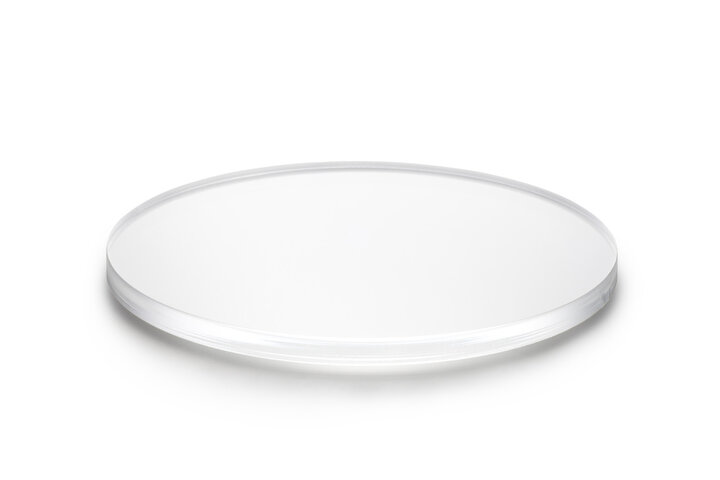
PMMA vs. Glass
PMMA vs. Polycarbonate (PC)
Strength and impact resistance
Optical clarity and weathering resistance
Chemical resistance and thermal stability
PMMA has better chemical resistance, especially to acids and solvents
PC has a higher thermal resistance and can withstand higher temperatures
Cost and processing
PMMA is generally more affordable than PC
Both materials can be processed using similar techniques, such as injection molding and extrusion
For more information on polycarbonate, you can check our guide on PC plastic.
PMMA vs. Other Engineering Plastics
For more details on these materials, you can refer to our guides on ABS plastic, PET plastic, and PA plastic (Nylon).
Here's a comparison table summarizing the key differences:
| Property | PMMA | Glass | PC | ABS | PET | Nylon |
| Optical Clarity | ★★★★★ | ★★★★★ | ★★★★ | ★ | ★★★ | ★ |
| Impact Resistance | ★★★ | ★ | ★★★★★ | ★★★★ | ★★★ | ★★★★ |
| Weathering Resistance | ★★★★ | ★★★ | ★★★ | ★★ | ★★★ | ★★★ |
| Chemical Resistance | ★★★★ | ★★★★ | ★★★ | ★★ | ★★★ | ★★★ |
| Thermal Stability | ★★★ | ★★★★ | ★★★★ | ★★ | ★★★ | ★★★★ |
| Cost-Effectiveness | ★★★★ | ★★ | ★★★ | ★★★★ | ★★★ | ★★★ |
When selecting a material, consider the specific requirements of your application. Factors such as transparency, impact resistance, weathering stability, chemical resistance, thermal stability, and cost should be taken into account.
PMMA offers a unique combination of properties that make it suitable for a wide range of applications. Its excellent optical clarity, UV resistance, and chemical resistance set it apart from many other engineering plastics.
However, in applications where extreme impact resistance or high-temperature stability is required, materials like polycarbonate or nylon may be more suitable.
For more information on processing these materials, you might be interested in our guides on acrylic injection molding and injection molding machines.
Environmental and Safety Aspects of PMMA Plastic
When considering the use of PMMA, it's crucial to evaluate its environmental impact and safety aspects. Let's explore PMMA's recyclability, toxicity concerns, and relevant regulations and standards.
Recyclability and Sustainability
Recycling methods and challenges
PMMA is 100% recyclable
Recycling can be done through pyrolysis or depolymerization
Challenges include sorting, contamination, and quality of recycled material
Environmental impact and energy consumption
Sustainable production initiatives
Toxicity and Health Concerns
BPA-free and food contact safety
Combustion byproducts and smoke toxicity
Occupational exposure and handling precautions
Regulations and Standards
REACH and RoHS compliance
PMMA complies with REACH (Registration, Evaluation, Authorization, and Restriction of Chemicals) regulations
It also meets RoHS (Restriction of Hazardous Substances) standards
UL 94 flammability rating
PMMA has a UL 94 HB rating, indicating horizontal burning
Flame-retardant additives can improve its fire resistance
ISO and ASTM testing methods
Here's a table summarizing the key environmental and safety aspects of PMMA:
| Aspect | Details |
| Recyclability | 100% recyclable through pyrolysis or depolymerization |
| Environmental Impact | Requires energy and resources; proper waste management is essential |
| Food Contact Safety | BPA-free and FDA approved for food contact |
| Combustion Byproducts | Releases heat and smoke when burned; proper fire safety measures needed |
| Occupational Exposure | Dust and fumes can cause respiratory irritation; PPE recommended |
| REACH and RoHS | Complies with REACH and RoHS regulations |
| UL 94 Flammability | UL 94 HB rating; flame-retardant additives can improve fire resistance |
| ISO and ASTM Standards | Various standards used to evaluate properties and performance |
Conclusion
PMMA, or acrylic, is a versatile plastic with unique properties. It offers excellent transparency, durability, and weather resistance. PMMA can be enhanced with additives and processed using various methods to suit specific applications.
Choosing the right material is crucial for successful product design. PMMA's properties make it suitable for automotive, construction, medical, and consumer goods applications.
Tips: You maybe interested to the all plastics


















